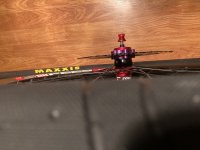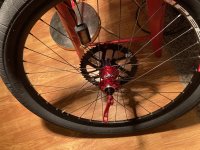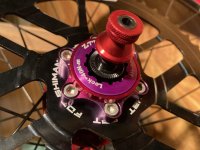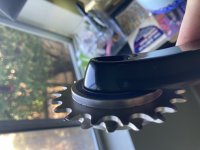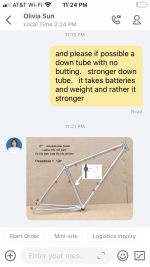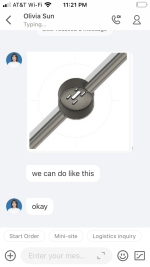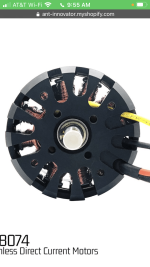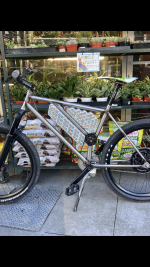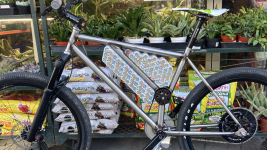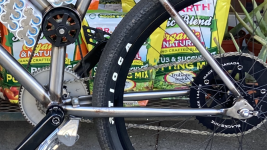So apparently we're only focused on the rear wheel and rear drivetrain components? Can't qualify this as to ebikes because I don't think we've seen enough of them as factory bikes...Trek and Spec...or homebrew bikes like with a Bafang for a long enough time come through the bike shop to get a decent feel for specific failure parts.
However, we've had a long exposure to gasoline engine conversions. Not an exact comparison, of course, but it is power to the rear wheel on a normal bicycle with a motor. There is one consistent failure with most all of them...the rear wheel. Some of these are a single rear cog setup and some have a normal multi-cog rear drive. Surprisingly it's the rear wheel that seems to disintegrate at the spokes...breaking and out of tension...instead of any drivetrain components...though I'm sure chain wear and cog wear are accelerated. Still, the rear wheels don't stand up to this use at all.
Now, here's another angle. We don't work on these gas conversions...liability and the funky nature of most of the designs. But we have told many of these owners that a standard single wall rim isn't up to the task of this application. Some are on Walmart level POS bikes with cheesy wheels, so one could chalk it up to that. However, we see this too. Most of these guys are absolute cheap bastids, and a lot of them are DL suspended drunks. We tell everyone of them when they come in to buy a wheel that a cheap, single wall rimmed wheel...even steel...that it won't last. We tell them if they're serious about making the rear wheel last, they need a stronger wheel. Only a handful were willing to try that. We make no guarantees on any wheel that goes on a gas conversion...we note in our store computer.
We've actually had a few buy a near DH level complete MTB wheel and hub setup. Those lasted a very long time, but even those eventually fell apart. Now, I'm pretty sure those wheels weren't properly maintained over that time with good attention to spoke integrity, but at least they did last a good while.
Now...does this apply to the OP's question about the rear wheel and drivetrain? I don't know. But I can't currently recall any drivetrain failures these gas engine guys have had other than chains and rear wheels. Obviously these gas conversion guys are all over the board with single cogs in the rear, cassettes, freewheels, and even some cheap IGH's. It's still the rear wheels that have fallen apart in "most" of these cases before any of the other components. Just throwing this out for food for thought...not sure if precisely applicable at all.
Now let me throw out just my personal experience. I did my BBSHD conversion to my older '08 Santa Cruz Nomad early this year and have been riding hard off road since April...my first ebike of any kind but obviously not my first bike. My rear wheel has an XT 6-bolt disc hub with a solid axle conversion with track axle nuts. The rim is a Mavic EX325-Disc mounted with 32,14ga, DT, SS spokes. This rim is an AM/Enduro level rim and is quite sturdy. I've used 3 of these identical wheels on my long travel, big hit MTB's with absolutely no issues over years of abuse...Moab and other hardcore off road riding...hardly even have to look at them for truing and such. In the short time I've been riding my Nomad/BBSDH with a relatively new wheel...same EX325...I've had to check and tension spokes every 2-3 rides...something I never had to do. I'm not riding any harder and no Moab trips.
Here's my 2 cents. OP seems interested in how power is/can affect the rear wheel and drivetrain. I think we're overlooking how weight plays into this too. Sure, my BBSHD is pumping more torque into my nice, strong rear wheel, but that wheel is also now dealing with a 50 pound bike rather than a 34 pound bike...and then throw my 8 pound battery in my backpack on top of that. It seems that "most" ebikes are heavy. That "AND" the power are both hard on our rear wheels. Throw in using the bike for real off road riding, and you have rear wheel torture.
I say this frequently but it applies. Many/most of these discussions about ebikes are all over the board. Do we have any idea what application the OP's "my electric bike" covers? How does it get used? And what is the "typical 32-spoke MTB wheel"...an XC weight weenie racing wheel with 24 spokes or a DH level bombproof anvil? I'm not dissin' the OP. I'm just saying we don't have enough info to answer his question. Then why am I even interested in the issue? I think I'm starting to see the weak link in my application...the rear wheel strength/integrity...for ebike use for off road. And some of this may apply to ebikes in general in some sort of way. We have more power than our puny bodies can produce on the pedals..and often a throttle option...and we have noticeably more weight to deal with. Maybe street applications will just take a little more time to destroy their parts than off road. I'm going with the rear wheel at the spokes and rim as being the "general" weakest link based so far on what I'm seeing. Sure, if you try to run super lightweight hubs and such, you add another weak link to the mix, but right now I'm going with spokes and rim. It's a hard life back there for a rear wheel and a motor.


